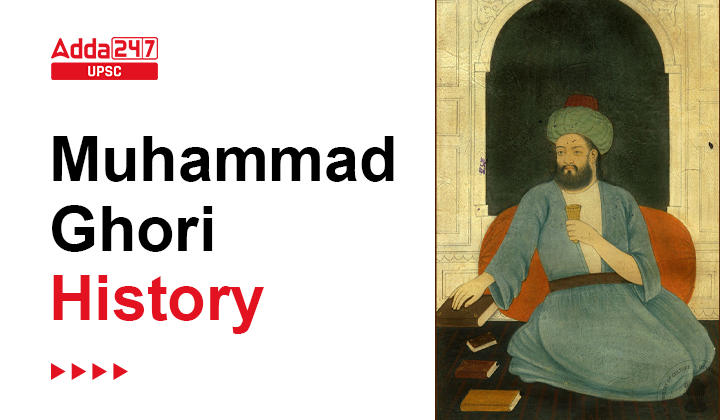Table of Contents
Muhammad Ghori, also known as Ghor, was a prominent military and political leader of the 12th century. He was the ruler of the Ghori Empire, which was centered in present-day Afghanistan and parts of India. Muhmmad Ghori is best known for his invasions of northern India and his role in establishing Muslim rule in the region. He defeated several Hindu kingdoms, including the Rajput Confederacy, and laid the foundation for the Delhi Sultanate. His campaigns marked the beginning of Muslim dominance in northern India and had a lasting impact on the region’s history. Ghori’s empire collapsed after his death in 1206. In this article, we will discuss about the History and his conflicts of Muhammad Ghori.
who was Muhammad Ghori ?
Muhammad Ghori was also known as Mu’izz ad-Din Muhammad Ghori or Shihab ad-Din Muhammad Ghori (c. 1149 – 1206). He was a ruler of the Shansbaani Dynasty. This Dynasty was an Afghan-based empire. Muhammad Ghori was of Persian origin, however, his exact ethnicity is still debated.
He ruled a large area comprising parts of modern-day Afghanistan, Pakistan, India, Iran, Bangladesh, Turkmenistan, Tajikistan together with his elder brother Ghiyath al-Din Muhammad (c. 1139-1202 CE).
Rise of Ghurids
The Ghurids were a Central Asian dynasty that rose to power in the 12th century. Led by the powerful Sultan Muhammad of Ghor, they established their dominance over an area encompassing modern-day Afghanistan and parts of Iran, Pakistan, and India. The Ghurids were known for their military prowess and successful conquests, including the defeat of the Ghaznavids. They played a significant role in the spread of Islam, constructing grand mosques and promoting religious tolerance. The Ghurid Empire thrived for a few centuries before declining in the 13th century due to internal conflicts and external invasions, marking the end of their influential reign.
Background for Conflict between Muhammad Ghori and Other Indian Rulers
In the late 12th century, Muhammad Ghori has exastablished as a powerful Muslim ruler of Afghanistan and He had embarked on a series of military campaigns in the Indian subcontinent. Muhammad Ghori’s objective was to establish Muslim dominance and expand his empire. However, his efforts were met with resistance from various Indian rulers who sought to defend their territories and preserve their own power. Prominent among these rulers were Prithviraj Chauhan of the Rajput kingdom of Delhi and Jayachandra of Kannauj. The conflict between Muhammad Ghori and these Indian rulers represented a clash of cultures, religions, and ambitions, ultimately shaping the course of medieval Indian history.
First Battle of Tarain in 1191
The First Battle of Tarain took place in the year 1191 between the forces of Prithviraj Chauhan, the king of the Chauhan dynasty, and Muhammad Ghori. It marked a significant conflict in the struggle for control over northern India. The battle was fierce, with both sides displaying valor and tactical prowess. Despite initial setbacks, Prithviraj Chauhan managed to rally his forces and launched a counterattack, inflicting heavy casualties on the Ghurid army. However, a strategic blunder allowed Muhammad Ghori to turn the tide in his favor, resulting in Prithviraj’s defeat. The battle set the stage for future conflicts between the two powers.
The Second Battle of Tarain in 1192
The Second Battle of Tarain took place in 1192 between the forces of Prithviraj Chauhan, the ruler of the Chauhan dynasty, and Muhammad of Ghor, the Sultan of the Ghurid Empire. Prithviraj Chauhan had initially defeated Muhammad of Ghor in the First Battle of Tarain in 1191 but failed to capture and eliminate him. In the Second Battle of Tarain, Muhammad of Ghor launched a fierce assault, utilizing superior tactics and a large cavalry force. Prithviraj Chauhan’s army was eventually overwhelmed, and he was captured, leading to the establishment of Muslim rule in northern India.
Mohammad Ghori’s Conquest of Bihar and Bengal
In conquest of Bihar and Bengal, Mohammad Ghori employed a combination of military strategy, diplomacy, and skilled generalship. Through fierce battles and strategic alliances, Ghori gradually gained control over the region, defeating local Hindu rulers and establishing Muslim rule. This conquest marked an important chapter in the spread of Islam in the Indian subcontinent and laid the foundation for subsequent Muslim dynasties that would shape the history of the region.
Battle of Chandawar
The Battle of Chandawar was fought in 1194 between the Ghurid dynasty, led by Muhammad of Ghor, and the Chahamana dynasty, led by Prithviraj Chauhan. The Ghurids emerged victorious, marking a significant turning point in North Indian history and paving the way for their dominance in the region.
How did Muhammad Ghori Die?
His death occurred in 1206, and the exact circumstances surrounding his demise are subject to some debate. While historical accounts may vary, here are some points regarding the possible events surrounding Muhammad Ghori’s death.
Muhammad Ghori succumbed to his injuries and died shortly after the Battle of Jhelum. His death marked the end of his rule and the beginning of a power struggle among his successors.
It’s important to note that historical events from this time period can be subject to varying interpretations and discrepancies due to the limited availability of sources and the passage of time.
| Relatable Articles | |
| List of Chief Election Commissioner | Biography of Bhagat Singh |
| Lala Lajpat rai punjab kesari | Mangal-Pandey |
| Follow US |
| UPSC Govt Jobs UPSC Current Affairs UPSC Judiciary PCS Download Adda 247 App here to get the latest updates |



 TSPSC Group 1 Question Paper 2024, Downl...
TSPSC Group 1 Question Paper 2024, Downl...
 TSPSC Group 1 Answer key 2024 Out, Downl...
TSPSC Group 1 Answer key 2024 Out, Downl...
 UPSC Prelims 2024 Question Paper, Downlo...
UPSC Prelims 2024 Question Paper, Downlo...
